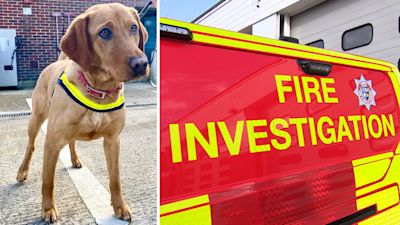Dogs and drones to help investigate major fires across the South East

Watch: Full report on efforts to raise the standard of fire investigations
Highly-trained sniffer dogs and aerial drones are to be used across the South East, as part of a new fire service collaboration.
It’ll see the four brigades covering Kent, Surrey and Sussex join forces to investigate serious and complex fires.
The new agreement will mean joint training courses and the ability to share personnel and specialist equipment across county borders.
The deal, announced last month, aims to provide “additional resilience” across the region, as well as ensuring a “consistency of approach” to fire investigation.
“It helps us all raise our game”, says Richard Moon from East Sussex Fire & Rescue Service. “The hope is that the standard of each individual fire investigator will be that much greater because of the joint training that we’re all doing.”
The service’s probe into a deadly blaze at a residential property in Eastbourne in 2009, which started in an electrical intake box in the cupboard under the stairs, led to national changes to wiring regulations.
“The investigator realised this wasn’t the first time he’d seen a fire like this,” Mr Moon explains. “The Electrical Safety Council got involved... It’s resulted in changes to the guidance that meter operators use when they’re inspecting and reading meters. It’s raised awareness across the country.”
The case highlights the main aim of fire investigations; to identify and understand the causes to help prevent future incidents.
In Sussex, Surrey and Kent there were 214 in-depth investigations into complex fires, known as Tier 2 investigations, in 2020-21. The four brigades currently have 33 trained fire investigation officers.
Watch: Richard Moon, East Sussex Fire & Rescue Service
Two-year-old Labrador Suki and her handler are one of the specialist resources which can be used, when required, across the region.
The Surrey Fire Service dog is trained to sniff out flammable fluids, such as petrol or oil, and can help search a large scene for potential clues.
Phil Bailey, from Kent Fire & Rescue Service, says: “Ideally you’d have a petrol can with an arrow on it, but the reality isn‘t like that. So, what we’re able to do is put the dog into a scene, and it is able to identify the possible presence of an accelerant, which will lead us to undertake further forensic analysis to see if that is the case.”
Watch: Phil Bailey, Kent Fire & Rescue Service
The new collaboration is also allowing for “bigger and better training days”, such as a recent event on forensics hosted at the University of Kent’s campus at Chatham.
Aerial drones are an example of the specialist equipment which can be called upon to assist with investigations, and the response to ongoing incidents.
The flying devices have cameras which can relay live images to firefighters on the ground, and also record evidence for investigations.
It’s not just staff and equipment which will be shared routinely but also data.
According to Richard Bradley, from West Sussex Fire & Rescue Service, the bigger pool of data will give them a greater understanding of emerging trends. “For instance, if there's a problem with a certain type of washing machine, or if we’re getting fires in a certain demographic area, we can then put in our resources with our prevention team to work in those areas.”
The collaboration involves Surrey, Kent, East Sussex and West Sussex fire and rescue services.
It’s hoped the new regime will help raise standards of investigation across the region, and help prevent future tragedies.